WordPress varsayılan olarak blog yazılarınızı ana sayfada görüntüler. Ancak, bir işletme web sitesi yapıyorsanız veya sadece ana sayfanızı özelleştirmek istiyorsanız, blog bölümünüz için ayrı bir sayfa isteyebilirsiniz.
Bu kurulum yalnızca ana sayfanızı temiz ve odaklanmış tutmanıza yardımcı olmakla kalmaz, aynı zamanda okuyucuların blog içeriğinizi keşfetmeleri için özel bir alan sağlar.
Kullanıcı deneyimini iyileştirmek ve tekliflerimize net bir şekilde odaklanmayı sürdürmek için, WPForms, OptinMonster ve All in One SEO dahil olmak üzere ortak şirketlerimizin web sitelerinin çoğuna ayrı blog sayfaları ekledik. Bu, ziyaretçilerin blog içeriğine kolayca erişmesini sağlarken, eklentilerimizi tanıtma ana hedefine öncelik veriyor.
Bu makalede, WordPress’te blog yazıları için ayrı bir sayfa oluşturmanın iki yolunu göstereceğiz.
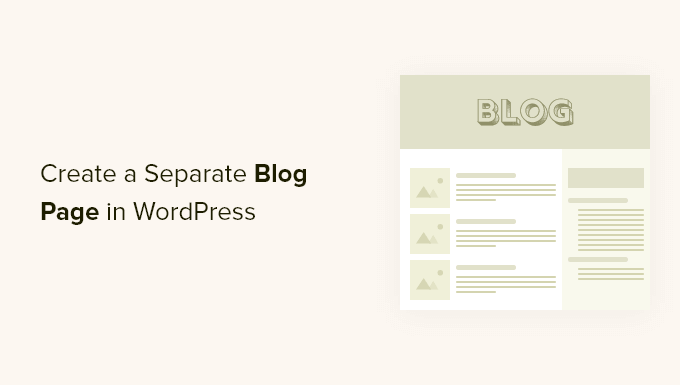
Blog Yazılarını Neden Ayrı Bir Sayfada Görüntüleyelim?
Ana sayfa, WordPress web sitenizin ön sayfasıdır ve ziyaretçilerinizin gördüğü ilk sayfadır. Varsayılan olarak, WordPress en son gönderilerinizi ana sayfanızda gösterir ve bir blog çalıştırıyorsanız bu mantıklıdır.
Ancak küçük işletme web siteleri için her zaman ideal değildir. Muhtemelen kullanıcılara işletmeniz, ürünleriniz ve hizmetleriniz hakkında bilgi veren, sizinle nasıl iletişime geçeceklerini bildiren ve satış dönüşümünüzü artıran daha ilgi çekici bir ana sayfa isteyeceksiniz.
Şimdi, web sitenizde bir blog da çalıştırmak istiyorsanız, ziyaretçilerin yazılarınızı okumak için gidebilecekleri başka bir sayfa sağlamanız gerekecektir.
Bunu söyledikten sonra, WordPress’te blog yazıları için nasıl kolayca ayrı bir sayfa oluşturabileceğinizi göstereceğiz.
Bu eğitimde iki yöntemi ele aldık ve aşağıdaki bağlantıları kullanarak istediğiniz yönteme geçebilirsiniz. İkinci yöntemin en basit yöntem olduğunu ve en fazla özelleştirmeyi sunduğunu unutmayın:
Video Eğitimi
Yazılı talimatları tercih ediyorsanız, okumaya devam edin.
Yöntem 1: WordPress’te Blog Yazıları için Ayrı Sayfalar Oluşturma
Varsayılan WordPress ayarlarını kullanarak blog yazıları için ayrı bir sayfa oluşturabilirsiniz.
Ancak bu yöntem, Yöntem 2’ye göre biraz daha fazla çalışma gerektirir ve çok fazla özelleştirme seçeneği sunmaz.
Ayrı Bir Ana Sayfa ve Blog Sayfası Oluşturma
Öncelikle, ana sayfanız ve blog sayfanız olarak kullanmak üzere iki ayrı WordPress sayfası oluşturmalısınız.
Bu sayfalara herhangi bir içerik eklemenize gerek yoktur ve istediğiniz herhangi bir ismi verebilirsiniz. Örneğin, bazı işletme web siteleri blog sayfaları için ‘Haberler’ adını kullanır.
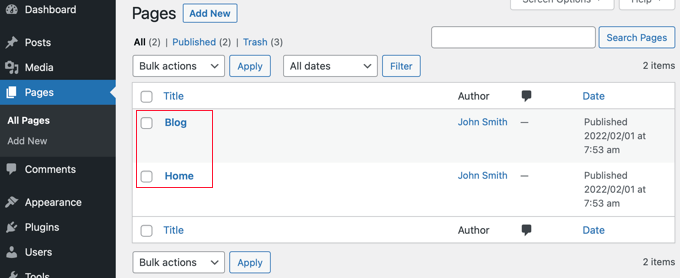
Bu sayfaları oluşturduktan sonra, WordPress yönetici alanındaki Ayarlar ” Okuma sayfasını ziyaret edin.
Şimdi, ‘Ana sayfa görüntüleriniz’ etiketli bölümün altında, ‘Statik bir sayfa’ düğmesine tıklamanız gerekir.
Bundan sonra, daha önce oluşturduğunuz Ana Sayfa ve Blog sayfalarını seçebilirsiniz. Daha sonra aşağı kaydırmalı ve ‘Değişiklikleri Kaydet’ düğmesine tıklamalısınız.

Şimdi, WordPress panosundan Sayfalar ” Tüm Sayfalar ekranına gittiğinizde, Ana sayfanın ‘Ön Sayfa’ ve Blog sayfasının ‘Yazılar Sayfası’ olarak etiketlendiğini göreceksiniz.
Devam edin ve önizleme yapmak için Blog sayfasının altındaki ‘Görüntüle’ bağlantısına tıklayın.
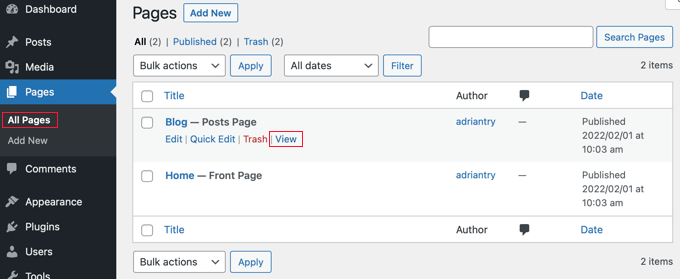
Bu sayfaların görünümü WordPress temanıza bağlıdır ve bu ayarları yapılandırmak isteyebilirsiniz.
Örneğin, temanızda bir gezinti menüsü varsa, WordPress’in yeni Blog ve Ana Sayfa sayfalarını otomatik olarak eklediğini fark edeceksiniz. Eğer yoksa, WordPress’te navigasyon menüsünün nasıl ekleneceğine ilişkin başlangıç kılavuzumuza bakın.
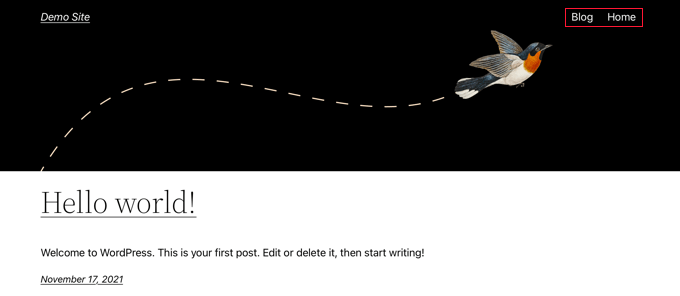
Ana Sayfanızı Özelleştirme
Şimdiye kadar yeni ana sayfanız boştu. Şimdi işiniz, ürünleriniz ve hizmetleriniz hakkında bilgi eklemenin ve ziyaretçilerinize sizinle nasıl iletişime geçebileceklerini bildirmenin zamanı geldi.
Bunu nasıl yapacağınızı WordPress’te özel bir ana sayfa oluşturma kılavuzumuzda öğrenebilirsiniz. Yöntem 1’de, kapak resimleri, sütunlar, tablolar, metin ve medya, galeriler ve daha fazlasını eklemek için blok düzenleyiciyi nasıl kullanacağınızı gösteriyoruz.
WordPress ana sayfasını kolay ve etkili bir şekilde düzenleme hakkındaki kılavuzumuzda da birçok yaratıcı özelleştirme fikri bulacaksınız.
Blog Sayfanızı Özelleştirme
Blog sayfanızın görünümünden memnunsanız işiniz bitmiş demektir.
Ancak, şu anda blok tabanlı bir tema kullanıyorsanız, WordPress panosundan Görünüm ” Düzenleyici ekranını ziyaret ederek blog sayfanızı da özelleştirebilirsiniz.
Oraya geldiğinizde, tam site düzenleyicisinde sol sütundan ‘Sayfalar’ seçeneğini seçin.
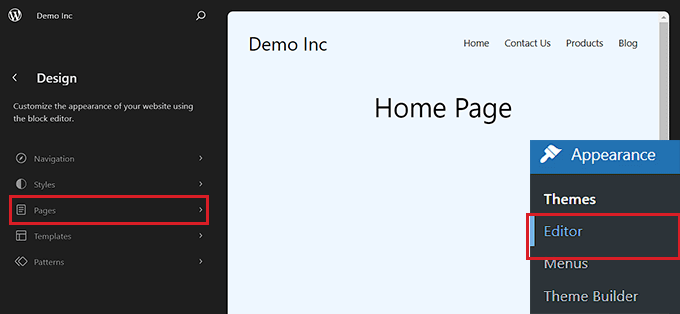
Bu, sol sütunda web sitenizdeki tüm sayfaların bir listesini açacaktır.
Buradan, ‘Blog’ sayfası seçeneğini seçin ve ardından blog sayfanızı özelleştirmeye başlamak için sağdaki sayfa önizlemesine tıklayın.
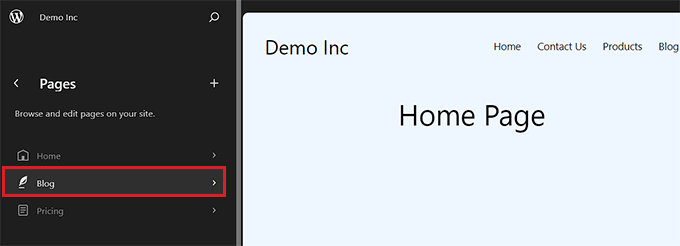
Artık ekranın sol üst köşesindeki blok ekle ‘+’ düğmesine tıklayabilir ve seçtiğiniz blokları sayfaya ekleyebilirsiniz.
Ayrıca, ekranın sağ üst köşesindeki ‘Stiller’ simgesine tıklayarak blog sayfanızdaki arka plan, metin veya bağlantı rengini değiştirebilirsiniz.
Bu, sağ tarafta metin rengini değiştirmek için ‘Tipografi’ sekmesine, arka plan rengini değiştirmek için ‘Renkler’ sekmesine ve blog sayfanızın boyutlarını yapılandırmak için ‘Düzen’ sekmesine tıklayabileceğiniz bir blok paneli açacaktır.
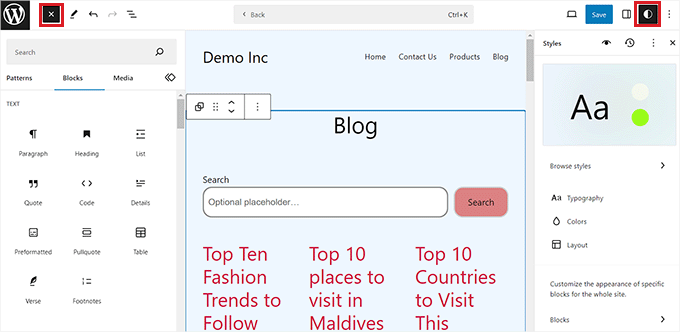
İşiniz bittiğinde, ayarlarınızı saklamak için üstteki ‘Kaydet’ düğmesine tıklamayı unutmayın.
Şimdi, nasıl göründüğünü görmek için WordPress blog sayfanızı ziyaret edebilirsiniz.
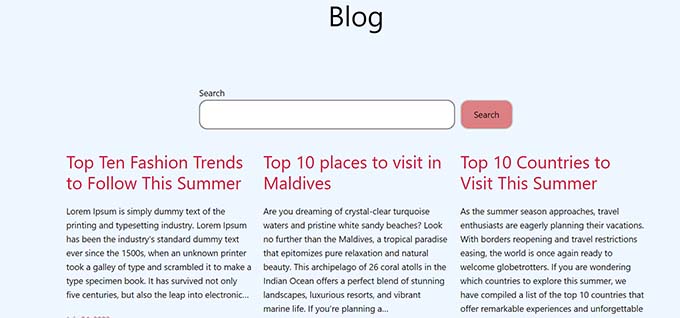
Ancak klasik bir tema kullanıyorsanız blog yazısı sayfanızı özelleştirmek için bunun yerine Yöntem 2’yi kullanmanız gerekecektir.
Yöntem 2: Sürükle ve Bırak Oluşturucu ile Blog Yazıları için Özelleştirilmiş Bir Sayfa Oluşturma (Önerilen)
Bir tema oluşturucu eklentisi, herhangi bir kod olmadan kolayca özel bir WordPress teması oluşturmanıza olanak tanır. Buna blog yazıları için ayrı bir sayfa oluşturma ve özelleştirme yeteneği de dahildir.
SeedProd Tema Oluşturucuyu Yükleme
Öncelikle SeedProd eklentisini yüklemeniz ve etkinleştirmeniz gerekir. Daha fazla ayrıntı için, bir WordPress eklentisinin nasıl kurulacağına ilişkin adım adım kılavuzumuza bakın.
SeedProd, işletmeler, blog yazarları ve web sitesi sahipleri için en iyi sürükle ve bırak WordPress sayfa oluşturucusudur. Ayrıca blog sayfanızı ve çok daha fazlasını kolayca özelleştirmenizi sağlayan bir tema tasarımcısına sahiptir.
Daha fazla ayrıntı için SeedProd incelememizin tamamını okuyabilirsiniz.
Etkinleştirmenin ardından, lisans anahtarınızı girmek için SeedProd ” Ayarlar sayfasını ziyaret edin. Bu bilgiyi SeedProd web sitesindeki hesabınızda bulabilirsiniz.

Bundan sonra sıra özel bir WordPress teması oluşturmaya geliyor. Bu göründüğünden çok daha basittir.
Özel WordPress Teması Oluşturma
Öncelikle SeedProd ” Tema Oluşturucu sayfasını ziyaret etmeniz gerekiyor. Burada, SeedProd’un hazır temalarından birini başlangıç noktası olarak kullanacaksınız. Bu, mevcut WordPress temanızı yeni, özel bir tasarımla değiştirecektir.
Bunu ‘Temalar’ düğmesine tıklayarak yapabilirsiniz.
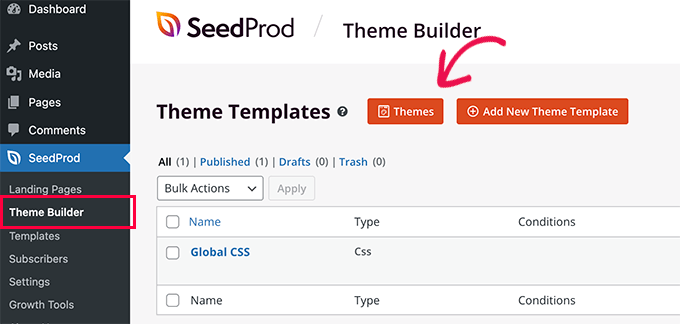
Şimdi size farklı web sitesi türleri için tasarlanmış profesyonelce tasarlanmış temaların bir listesi gösterilecektir.
Örneğin, ‘Modern İşletme’, ‘Pazarlama Ajansı’ ve ‘Mortgage Broker Teması’ adlı şablonlar vardır.
Seçeneklere bir göz atın ve onay işareti simgesine tıklayarak ihtiyaçlarınıza en uygun olanı seçin.
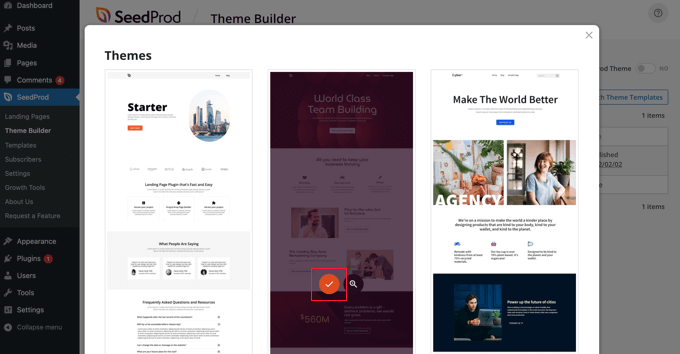
Bir tema seçtikten sonra SeedProd, blog dizininiz için bir tane ve ana sayfanız için bir tane olmak üzere tüm tema şablonlarını oluşturacaktır.
Bunlar sadece boş sayfalar olmayıp, özelleştirilmesi kolay çekici düzenler ve yer tutucu içeriklerle birlikte gelir.
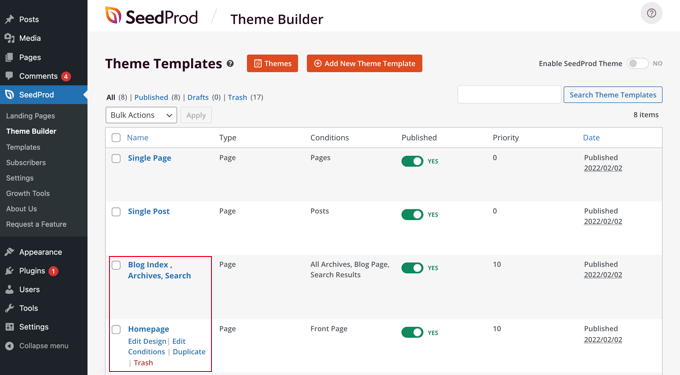
Bu eğitimde, ana sayfa ve blog dizini şablonlarını nasıl özelleştireceğinizi göstereceğiz.
Diğer şablonları da özelleştirmek isteyebilirsiniz. Bunu nasıl yapacağınızı öğrenmek için özel bir WordPress temasının nasıl kolayca oluşturulacağına ilişkin başlangıç kılavuzumuza bakın.
Ana Sayfanızı Özelleştirme
Tema şablonlarınızı oluşturduktan sonra, SeedProd tema oluşturucusunu kullanarak bunları düzenleyebilirsiniz. Ana Sayfa şablonu ile başlayacağız.
Başlamak için ana sayfanın altındaki ‘Tasarımı Düzenle’ bağlantısını tıklamanız yeterlidir.

Bu, şablon dosyasını SeedProd tema oluşturucusunda başlatacaktır.
Bu basit sürükle ve bırak oluşturucu, sağda sayfanızın canlı bir önizlemesini ve solda bir blok araç çubuğunu gösterecektir.
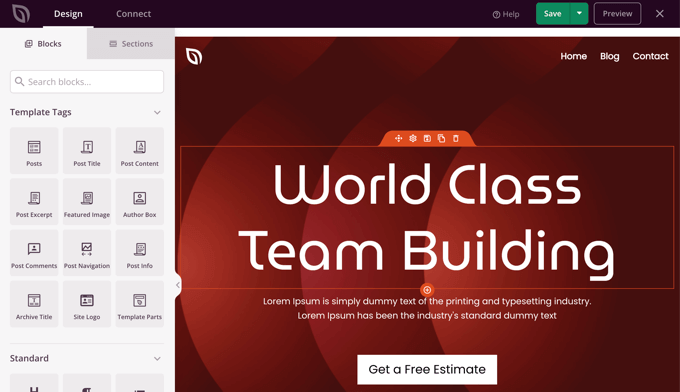
Herhangi bir bloğu üzerine tıklayarak, blokları farenizle yukarı ve aşağı sürükleyerek ve sayfaya yeni bloklar ekleyerek özelleştirebilirsiniz.
WordPress’te özel bir ana sayfanın nasıl oluşturulacağına dair eksiksiz bir kılavuz yazdık. SeedProd kullanarak ana sayfanızı nasıl özelleştireceğinizi öğrenmek için Yöntem 2’ye ilerlemeniz yeterlidir.
Blog Sayfanızı Özelleştirme
SeedProd tema oluşturucu ayrıca blog dizin sayfanızı özelleştirmek için birçok yol sunar.
Sayfanın altındaki ‘Tasarımı Düzenle’ bağlantısına tıklayarak başlayın.

Sağda aynı önizleme bölmesini ve solda araç çubuğunu göreceksiniz. Blog sayfasını ana sayfada yaptığınız gibi özelleştirebilirsiniz.
Örneğin, başlığa tıkladığınızda tüm ayarlarını görebileceksiniz. Metni düzenleyebilir, hizalamayı ve yazı tipi boyutunu değiştirebilir ve daha fazlasını yapabilirsiniz.
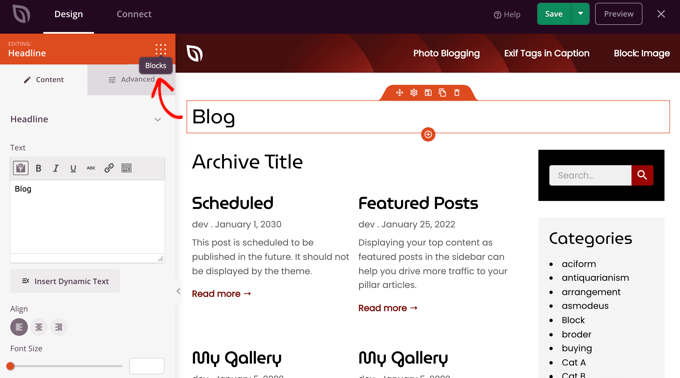
İşiniz bittiğinde, araç çubuğuna dönmek için ‘Bloklar’ simgesine tıklamanız gerekecektir.
SeedProd tema oluşturucu, blog yazılarınızın bir listesini görüntüleyen Yazılar bloğu gibi ek Şablon Parçaları blokları sunar.
Yazılar bloğu sizin için blog dizini şablonuna zaten eklenmiştir ve bu şablonda blok, yazılarınızı iki sütun halinde görüntüler. Bunu tek sütun olarak değiştirebiliriz.
Yazılar bloğuna tıklamanız ve ardından ‘Sütunlar’ ayarını 1 olarak değiştirmeniz yeterlidir.
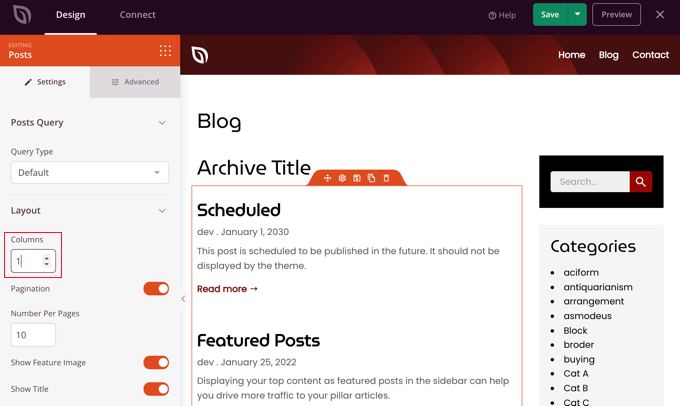
Düzen hemen tek bir sütuna dönüşecektir.
Yazılar bloğu ayarlarını aşağı kaydırdığınızda, yazının özellik resminin ve başlığının görüntülenip görüntülenmeyeceğini seçmenize olanak tanıyan geçiş anahtarları bulacaksınız. Ayrıca gönderi başlığı için hangi başlık etiketinin kullanılacağını da seçebilirsiniz.
Farklı gönderi meta verilerini görüntülemek için seçenekler de vardır. Değiştirilme tarihi, yazar, yayınlanma tarihi ve saati ile yorum sayısını değiştirebilirsiniz.
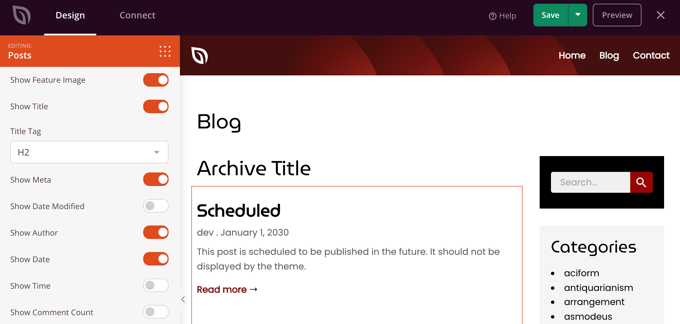
İşte blog dizininizi özelleştirebileceğiniz birkaç yol daha:
- Dizini gönderi türüne, kategoriye, etikete veya yazara göre filtreleyebilirsiniz.
- Gönderilerin sıralama düzeni değiştirilebilir.
- Bir sayfada kaç gönderinin görüntüleneceğini seçebilirsiniz.
- Yazı alıntısını değiştirebilir ve uzunluğunu özelleştirebilirsiniz.
Blog sayfanızı özelleştirmeyi tamamladıktan sonra, ekranın üst kısmındaki ‘Kaydet’ düğmesine tıkladığınızdan emin olun. Ardından, ‘X’ simgesine tıklayarak şablonlar listesine geri dönebilirsiniz.
SeedProd Temasını Etkinleştirme
Tema şablonlarını özelleştirmeyi tamamladıktan sonra, yeni özel temayı yayınlamanız gerekecektir.
‘SeedProd Temasını Etkinleştir’ ayarını ‘EVET’ konumuna getirmeniz yeterlidir.
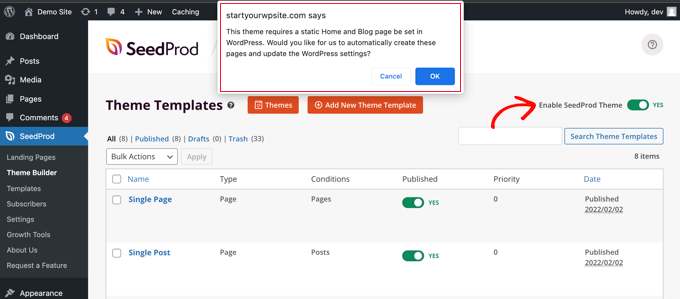
Hemen WordPress Ana Sayfa ve Blog sayfası ayarlarının değiştirilmesi gerektiğine dair bir bildirim göreceksiniz. ‘Tamam’ düğmesine tıkladığınızda, bu ayarlar sizin için değiştirilecektir.
Artık yeni ana sayfanızı ve blog sayfanızı görüntülemek için web sitenizi ziyaret edebilirsiniz. Demo sitemizde blog dizin sayfası bu şekilde görünüyor.
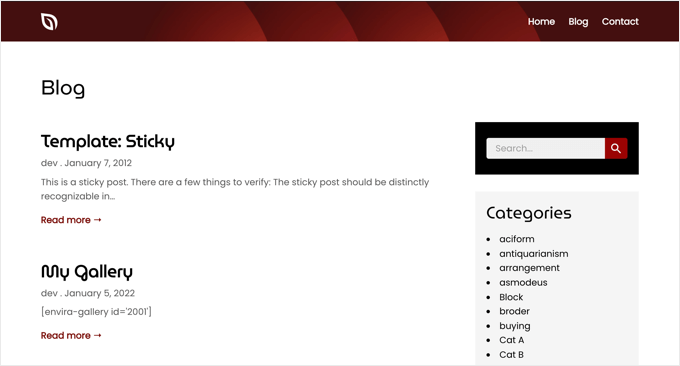
Bonus: WordPress’te Son Gönderilerinizi Görüntüleyin
Ayrı bir blog sayfası oluşturduktan sonra, kullanıcıları sitenizi daha fazla keşfetmeye teşvik etmek için ana sayfanızda bazı son gönderileri göstermeye devam edebilirsiniz.
Bunu yapmak için, WordPress blok düzenleyicisinde ana sayfanızı açın. Oraya geldiğinizde, blok menüsünü açmak için ekranın sol üst köşesindeki ‘Blok Ekle’ düğmesine tıklayın.
Buradan, sayfaya ‘Son Gönderiler’ bloğunu eklemeniz yeterlidir. Bunu yaptıktan sonra, son gönderilerin listesini gönderi alıntılarını, yazar adlarını ve tarihleri beğeninize göre görüntüleyecek şekilde özelleştirebilirsiniz.
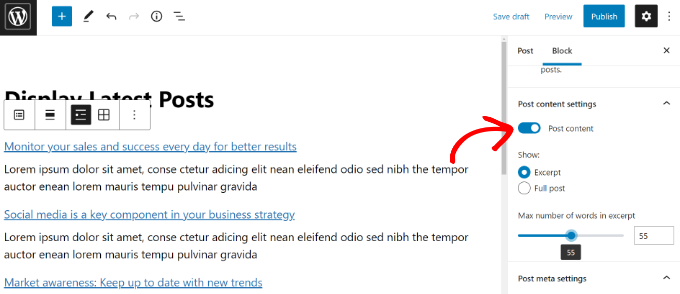
Son olarak, ayarlarınızı kaydetmek için en üstteki ‘Yayınla’ düğmesine tıklayın. Artık, kullanıcıların web sitenizde daha fazla zaman geçirmelerini sağlamak için son gönderilerinizden bazıları ana sayfada görüntülenmeye devam edecektir.
Daha fazla bilgi için WordPress’te son gönderilerin nasıl görüntüleneceğine ilişkin eğitimimize bakabilirsiniz.
Umarız bu eğitim WordPress’te blog yazıları için ayrı bir sayfa oluşturmayı öğrenmenize yardımcı olmuştur. Ayrıca WordPress’te blog yazıları için özel yazı durumu eklemeyi öğrenmek veya WordPress için en iyi ilgili yazılar eklentileri listemize göz atmak isteyebilirsiniz.
If you liked this article, then please subscribe to our YouTube Channel for WordPress video tutorials. You can also find us on Twitter and Facebook.





HP
Thank you!!!!!!
WPBeginner Staff
Simply go to Settings -> Permalinks and in the custom structure add this:
/blog/%postname%/
Braydan
How would I go about getting all “Posts” to display as “example.com/blog/my-blog-post” without having the pages of my website do the same?
Suvendra
Nice exactly what I was looking for
GO
Is there a way to post blog entries in different pages of the site? I would like to divide my blog into 3 section and post different blog entries in the different pages
Tom Durkin
Look at making a loop that only displays one category and then put those in custom templates for each of the pages.
Upasna
When I go to the ‘Template’ option, in the drop down list, there is no option for Front page Template..!! What do I do now??
Jess
I’m having the same problem
WPBeginner Support
If you do not see a Front Page Template, then this means that your theme does not have a template with this name. You can use a template provided by your theme or create a custom page template for your blog page.
Admin
ali
I make a blog in your described way but it goes to front page …..
means that when i click the blog in the menu it show the same page(front page).
i follow the exact way you mention in tutorial….
Please help.
bob
Great post. Thanks.
DrLightman
It works, expect in the case I want to use a custom template for the posts page.
Even if I’m allowed to pick the template when creating the Blog page, and I selecte this page in reading for posts, it seems WP always uses index.php instead of the custom template.
Ewa
I have the same problem and have no idea how to fix it Could anybody help..?
Could anybody help..?
Motener
Hi Sir/Mam
I NEED TO LEAR HOW TO MAKE A BLOG?
HOW I START?
WPBeginner Support
You can check out our guide on how to install WordPress, you can also take advantage of our free blog setup service.
Admin
Tash
Thank you for this! I’ve been working on creating a separate blog tab for my wordpress site and your process was outlined very well (easy to follow!). Thanks for help!
Shao
This was perfect, exactly what i needed. My previous sites used some complicated technique to show posts as a page. But using your method now shows a page with all our blog posts! So simple! Keep up the helpful tips. Am def coming back here if i run into any more issues with WordPress.
Matt
Thanks for this, it worked perfectly on my site using the default 2014 theme.
Ana Estrada
I tried adding the blog to my website, but I does not come out correctly. When I set the home page as the front page and the blog page as the post page, the content on the blog page is the exact same contact you see on my home page. How would I be able to fix this?
Mauro Mascia
Take a look at here:
http://codex.wordpress.org/images/1/18/Template_Hierarchy.png
and double check what template is used for the homepage and what is the default template.
In my case there was a home.php, which is used as default if no template is specified in the blog page.
Johanna
Thank you very much! This guide solved the exact problem I had.
Simon
Simple instructions but no results, doesnt work but thanks for trying
Edgar Lopez
Don’t say “it doesn’t work” when it obviously does based on the other comments. Sounds like it is user error.
Anastasia
I did that and lost my homepage :((( it says: 404 — Fancy meeting you here!
Don’t panic, we’ll get through this together. Let’s explore our options here.
I’m using Responsive theme… Please help!
Krish
Thank you
kyra
hi there… I am using the Customiz’r theme and I am not able to designate my homepage as an actual ‘page’. I want the homepage to be what it is now (see codecompliedcheck.com), but this page shows up in the menu as ‘Custom’, not as ‘Page’, so when I go to the setting to designate my actual homepage as the ‘static page’, it’s not even in the dropdown menu for me to choose. Which means that I’m not able to designate the ‘CCC Blog’ page I created as the ‘posts page’. Can you help me figure this out? Thanks in advance.
WPBeginner Support
Kyra, we don’t provide support for WordPress themes (because there are thousands of them). However, did you check theme customize screen located under Appearance » Themes » Customize. You will probably see front page options there.
Admin
Kelsey
Kyra did you figure it out? I am having the same problem.
Justin
I am having the same problem as Kyra and Kelsey. Any luck??
Digiwebpro
What about SEO? this page should be indexed? If the page shows the snippets of the posts, then is considerated like duplicate content? Thanks
WPBeginner Support
No if it shows snippets of posts, then it is not considered duplicate.
Admin
Arianne
How do you get snip it’s to show? I’ve gone to settings – reading -and checked summary, but my blog still shows the full length of the post.
WPBeginner Support
Check our guide on how to display post excerpts in WordPress themes.
edwin
Hi, thanks for your tutorial, I want to know if it´s posible to have two diferent pages showing diferent posts from a wordpress site. thanks.
WPBeginner Support
Yes it is possible.
Admin
Cheryl
How?
WPBeginner Support
Create a new template and use WP_Query to select the posts you want to display. We would try to cover this in a tutorial soon. see this:
Sam
Thanks for help.
Zeeshan
One more thing, i’ve asked for the help to support team and they told me to use Visual Composer to create that static home page and blog page, i don’t know how to use Visual Composer to create a static home page… If you are familiar with it then can you make a tutorial for that? It will be great if you make a tutorial for Visual Composer to create a static home page and blog pgae
WPBeginner Support
Zeeshan you need to create a new page. On the admin menu click on Pages and then on Add New. You will see that an editing interface will appear with a larger text box. This larger text box will have two buttons on top of it Visual and Text. The text editor is plain text editor with no styling buttons. The Visual editor has styling buttons and is supposed to be beginner friendly.
Admin
Zeeshan
Hi so would you please tell me any alternative or should i send you some screenshots to help me out further?
so would you please tell me any alternative or should i send you some screenshots to help me out further?
I’ve tried twice but it didn’t work for me coz there is no Front Page template exists in the theme, i am using Premium EffectiveNews theme from themesforest and i just wonder why it isn’t so modern lol… jokes apart anyways there are 6 templates exist in page attributes section 1-Default template 2-Authors 3-Contact us 4-Full width 5-Reviews 6-Sitemap… I’ve tried 2 times by selecting default template, disabled comments and trackbacks plus i changed Reading Settings also as static page, front page as “home” and posts page as “Blog” it didn’t work for me
WPBeginner Support
Please contact theme author for support
Admin
Todd
Hi-
I have a separate page for blog posts to appear, but the entire blog post appears (I’m displaying 10 at a time). How do I select just 55 words or such to appear instead of the entire blog post?
Thank you!
Todd
WPBeginner Support
Check out our guide on how to display post excerpts in WordPress themes.
Admin
Christine
Wow. Wonderful info. I still have a question. How can I create multiple blog pages? Is that possible? I would love to separate my blog posts by topic so I want to create multiple blog pages. Can you please help? Thank you.
WPBeginner Support
Christine to separate your blog into multiple pages by topics you already have Categories. You can then put those categories in your navigation menu from Appearance » Menus screen. If you want you can place categories as sub-menus under your blog page in the navigation menu.
Admin
Lucas
Simple and clear explanation.
Thanks for share
Luka
Hi,
I have difficulties with sliders now. Now the sliders from front static page are showing also in blog page and i don’t want slider there. Any idea how to remove sliders from blog page and still have blog page for posts?
Thanks!
G Bewley
Thank you very much!
Ryan McGovern
Thanks mate,
just what I needed.. so easy !!
Jason
Thanks so much
Becky
Thank you!
Davis Harrigan
I’m using Skylark as my theme – would these steps work to create a “custom”/another page where I can put posts?
WPBeginner Support
Yes, this should work fine on your theme.
Admin
Stuart
This article was so helpful! Thanks for putting it up!
Rick
How can I have some fixed introductory text on the blog page above the posts?
Thanks for your suggestionsa about creating the blog vs front page. Very helpful!
Leslie
Every time I search for help, I seem to run into one of your articles. They are very helpful! I’m hoping you may be able to work you magic on this problem….
A child theme was created specifically to help remove the page titles from showing up in the body of the site and remain solely in the tabs. This worked great until this week, the individual blog titles disappeared.
The code used is
.home h1.entry-title {
display: block;
}
Any suggestions?
Thank you.
WPBeginner Support
It is difficult to guess what could have gone wrong. Did you recently updated the parent or child theme or installed a new plugin?
Admin
Gauri
Great article. I am currently helping with a WP website where some posts were put up on a page. Now we want to stop posting on that page and post on another one, without losing the previous posts. How do i do that? Thanks.
WPBeginner Support
You can create a separate page. For example you had your posts on a page called Blog Posts and you want to move your posts to a new page called “News”. Then all you need to do is create a News page in WordPress. Go to Settings – Reading and select that page as your blog page. You can also create a custom page with a custom query to load only the specific posts on that page.
Admin
Kashif Khan
Awesome explanation in simple way.really very help full
Jenni
Thanks so much! I could work out how to write a page, and I could work out how to write a blog, but I could not work out how to write a blog in a page. Your step-by-step instructions worked perfectly. Another step in building my confidence, so thanks again
sommy uwakwe
Thanks for the article. I have created pages already and I want to be adding specific posts to specific pages. Like I have a page for music and poems so I want post music stuffs on the music page and poems on the other page. Please guide me through this
WPBeginner Support
Perhaps the best way to do this is by creating categories and using category archives.
Admin
Duska
Please, can you explain. I have categories, but can’t see how to use them for this. I want to choose before I click on publish button to which menu item to publish a post. Please, would you give specific steps for an example of this, or point to an article with explanation?
WPBeginner Support
You can add categories to your sidebar, from Appearance » Widgets screen. Click on Categories widget and drag and drop it to a sidebar and then preview your website. You can also add categories to your website’s navigation menu from Appearance » Menus screen.
Sonia
How do I get my blog posts to be housed under /blog/ (e.g. http://www.website.com/blog/blog-post-name)? If I write a post, I can’t do this and if I write a page, then it doesn’t function like a blog post (e.g. Not categorized, no date, no author).
jaiprakash
helpful indeed
thanks
Wesley
Thanks, bro!
Ignacio Castro
I have been using a WP theme called Customizr, and I haven’t figure it out how to get my blog up and running (I believe it’s a problem with the template, but it could just be me not knowing how to do it). Anyway, I will give it a try to the categories suggestion above, but is there a way to create a child page template that allows to get the posts into a page, if it doesn’t come with the theme? Thanks in advance.
Ignacio Castro
The categories option works, but I don’t like how the page looks, which again I think it depends on the theme you use. In mine, it basically shows a big Archive title at the beginning of the page, which doesn’t help much. Any feedback here is appreciated. Thanks.
Jahkie
this is actually pretty easy to follow..thanks
R Sharma
I used to have my blogs appear on a bespoke web page i.e. /whats-new/blog but after having a wordpress update they stopped appearing on the whats-new page but on a new page on their own i.e. /blog.
i tried what you’ve outlined above but cant get it to revert. Am i missing something?
WPBeginner Support
There could be quite a few reasons for that. First of all you should update your permalinks and see if this fixes the problem. If you are using a custom theme with homepage settings, then you should check those settings.
Admin
Jacobs
Nice one. Could you please suggest one or more themes that come with pages for blog posts, What I want is to be able to list topics of blogs related to every page on the page. For instance, I want to create pages for cars, boats and bikes. I want to have mysite.com/cars, mysite.com/boats, etc and I want blogs for each page listed accordingly. Please suggest any responsive theme that can do this. Thanks and cheers!
WPBeginner Support
You can easily do that by using categories. For example, you can publish posts in cars and boats categories and then add those categories to your WordPress Navigation menus from Appearance » Menus screen
Admin
paladin
Thanks for share
vico vo
Thanks. I turned off comment on page
Ankur Upadhyay
Thanks for this article. You made it look so easy. I will try it out on my blog.
Jigar Doshi
Very helpful indeed.
It is so much easier than I had thought it to be.
Thanks.